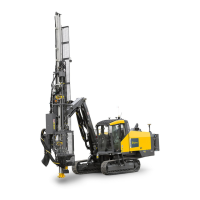SmartROC T35/T40 7 Noise and Vibration
32 No: 5966599819.1.5966707083 en-US
• Epiroc recommends a program of health surveillance to detect early symptoms caused
by exposure to noise and vibrations, so that management procedures can be modified
to prevent future impairment.
7.3 Causes of High Noise Levels
Noise levels higher than the stated values are likely to occur when:
• Working with open cab doors and windows
• Removing drill pipe or drill bit during percussive drilling
• Working underground
• Incorrectly using the machine
• Working with increased load when compared to specified values
• Using compressed air
7.4 Effects of Noise
Exposure to noise can result in adverse health effects, such as:
• Permanent hearing loss
• Tinnitus
• Fatigue and stress
• Balance issues
• Poor attention
• Impaired ability to communicate
• Impaired ability to perceive acoustic signals and warning signals
7.5 Noise Reduction Factors
To reduce risk from exposure to noise:
• Use approved hearing protection or plugs. Refer to guide, EN 458.
• Inspect and maintain all hearing protection regularly. For example, replace the hearing
protection seals every six months.
• Use helmet goggles if using hearing protection or, use ear plugs when using goggles
or protective safety glasses. Goggles and protective safety glasses reduce the effect of
the hearing protection.
• Make sure that ear plugs fit correctly in ear canals. Incorrect sizing of ear plugs re-
duces the damping effect.
• Do regular maintenance of door and cab seals, insulation, and mufflers.
• Work with a closed cab door and closed windows.
7.6 Noise Combined with Other Risk Factors
Noise, in combination with other risk factors, can cause serious health issues.
• Vibration and noise in combination can cause higher health risks.
• People with sensitive conditions (for example, pregnancy) and people already with im-
paired hearing may need protection against noise even at lower levels.
• Exposure to ototoxic substances and noise may increase the risk of hearing damage
(even under 80 dB). For example, styrene, toluene and xylene, and certain solvent
mixtures are ototoxic. Certain fuels such as kerosene and certain metals such as mer-
cury and lead have also been proven to be potentially ototoxic.

